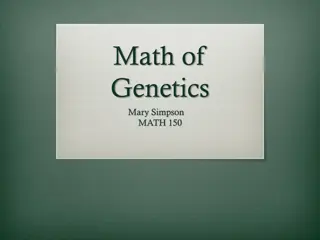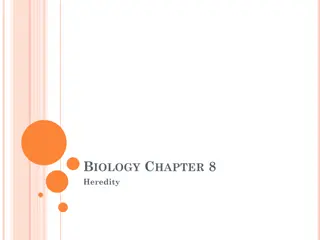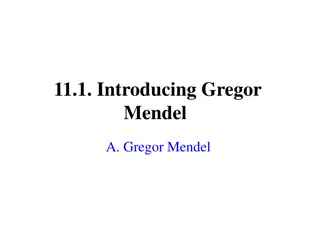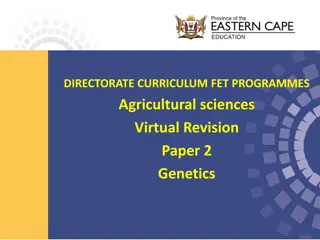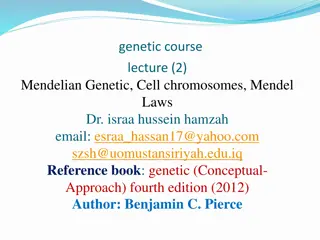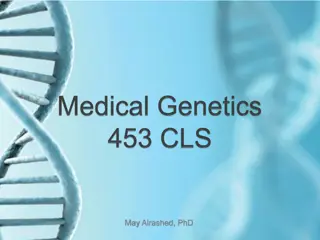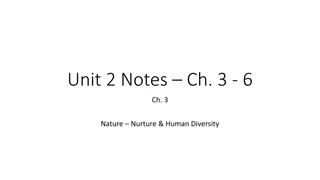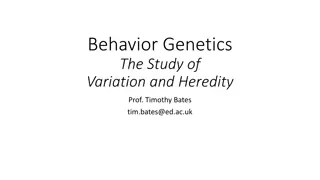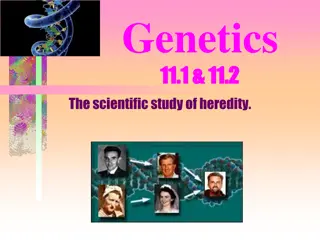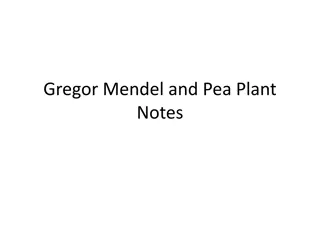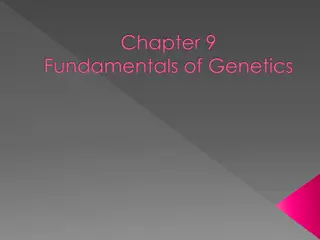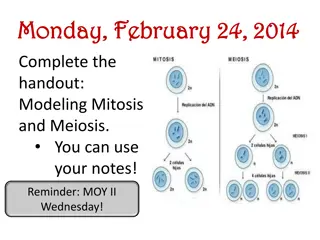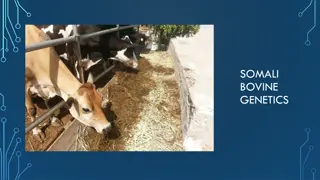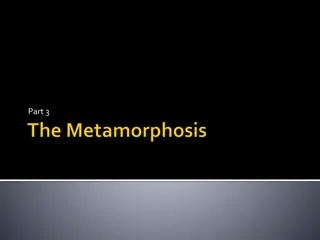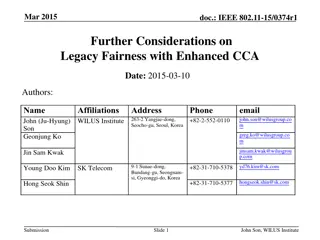Exploring the Legacy of Gregor Mendel: Pioneer of Genetics
Gregor Mendel, a father monk in the 1800s, conducted groundbreaking research on how traits are inherited through plants, laying the foundation for modern genetics. Despite initial lack of recognition, his work on pea plants led to the discovery of genetic factors and the understanding of hereditary traits. Mendel's dedication to science and meticulous experiments revolutionized the field of genetics, highlighting the importance of his contributions to biological knowledge.
Download Presentation

Please find below an Image/Link to download the presentation.
The content on the website is provided AS IS for your information and personal use only. It may not be sold, licensed, or shared on other websites without obtaining consent from the author. Download presentation by click this link. If you encounter any issues during the download, it is possible that the publisher has removed the file from their server.
E N D
Presentation Transcript
INSTRUCTIONS FOR ASSEMBLING PAGES 2 & 3 IN NOTE PACKET Cut out the four door table along the dark lines and glue the edges into your packet. The dotted lines are where the doors of the table fold.
WHO IS GREGOR MENDEL? In the mid to late 1800 s, a _____________ named Gregor Mendel researched how traits were ____________ by plants. His findings were not validated until decades after his death and now he is considered to be the ___________ of modern _____________. father monk inherited genetics
WHEN AND WHERE When: Born in 1822 and died in 1884 at 61. Between the years of 1856-1863 Mendel performed his pea plant experiments. He published his work in 1866, describing the invisible ________ which we now call _______ as the predictor for visible traits. factors genes
WHEN AND WHERE CONTINUED Where: Born in Austria a poor child, in 1843 his professors recommended he become an Augustinian ________ because of their value placed on math and science. He continued his education at the University. monk
WHY As the son of a ___________, Mendel had a genuine love for ________ and the sciences. While at the monastery he had an experimental ____________ at his disposal and began to research the transmission of hereditary ____________ in plant hybrids. He went on to disprove that hereditary traits of offspring are _________ of parent traits. blending farmer plants garden traits
HOW Over 8 years, Mendel studied inheritance by working with ______ plants because they were easy to _______. Using a paint brush to transfer ______, he cross-bred plants and conducted hybridization experiments on nearly ________ plants which allowed him to manipulate 7 of the plants __________ traits: plant color, plant height, pod shape and color, and flower position and color. pea breed pollen 29,000 observable
feature Characteristic - A __________ that has different _______ in a population. Mendel studied only one pea characteristic at a time. _______ - are different forms of a characteristic Dominant recessive __________ or ____________ forms Traits
SOME OF THE OBSERVABLE TRAITS OF THE PEA PLANTS MENDEL STUDIED
WHAT Mendel coined the terms _________ and __________ and developed the following laws: Law of Segregation: The two parts of a gene pair or alleles ________ from each other in the form of ______ cells. Half the sex cells carry one allele, and the other half carry the other allele. The Law of Independent Assortment: traits are passed on _____________ of other traits from parent to offspring. dominant recessive sex separate independently
BILL NYE GENES VIDEO 1. The way you are and the way you look when you are born is determined by your genes from your parents. 2. Your whole body is made of cells. 3. DNA has all the information needed to determine what you are.
4. Your genes are strung out on a DNA molecule. 5. Chromosomes are very long DNA molecules and are found in almost every living thing. 6. We need a lot of information or genes to make a person. 7. Genes are passed down from parents to their children.
8. Humans have 46 chromosomes and about 80,000 genes in each of their body cells. 9. Give some examples of what genes determine. nose size hair texture eye color hair color 10. The female reproductive cell is the egg. The male reproductive cell is the sperm.
11. Every living thing is made of DNA and four chemicals called: Adenine, Thymine, Cytosine, Guanine 12. The two types of genes are dominant and recessive. 13. Mutations are caused by jumbled up information. They can be harmful or helpful.
TRAITS AND INHERITANCE VOCABULARY Genetics The scientific study of heredity. DNA Contains your genes; found in the nucleus, blueprint for making protein. Video on DNA and Genes Video on Protein
Traits The different forms of a characteristic (dimples present or absent). Video on Traits Dominant An allele who s trait always shows up in an organism. Genotype Combination of alleles (letters: GG, Gg, gg)
Homozygous/Purebred An organism that has two dominant or two recessive alleles. (ex. GG or gg) Mitosis Cell reproduction when one body cell becomes two. Heredity Passing of traits from parents to offspring. Video on Heredity Genes the factor that controls a trait you exhibit (found on the chromosome).
Alleles Different forms of a gene. Recessive The trait that hides in the background (lowercase letter). Can only be expressed in the homozygous form (ex. gg). Phenotype The physical appearance of an organism. Heterozygous/hybrid The two alleles (letters) for one trait that are different (ex. Gg) CORRECT THIS IN YOUR NOTES! Meiosis Produces 4 sex cells, sperm or egg that are used to pass a parent s traits to offspring.
PUNNETT SQUARE VOCABULARY Example Word Definition The letters that represent the different forms of a gene. Alleles E or e Eye Color The different forms of a characteristic. Traits The trait that hides in the background and can only be expressed in homozygous form. Recessive e
Word Definition Example Genotype Combination of alleles. EE, Ee, or ee Two alleles/letters for one trait that are the same. EE or ee Homozygous/Purebred The trait that overshadows and is expressed. Dominant E Two alleles/letters for one trait that are different. Heterozygous/Hybrid Ee The physical appearance of a trait. Phenotype Green
MEIOSIS USE PAGES 126-132 IN TEXTBOOK TO HELP YOU. asexual In __________ reproduction, only one parent cell is needed for reproduction. sexual In __________ reproduction, two parent cells join together to form a new individual. 46 Human body cells have ___ chromosomes.
sex cells 23 Human _____ _____ have only ___ chromosomes-half the usual number. Male sex cells are called ______ Female sex cells are called ________. sperm eggs Meiosis _________ produces new sex cells with half the usual number of chromosomes. DNA Genes are located on _______ which are condensed in the nucleus as _______________ during the process of mitosis (cell replication). What is DNA Video chromosomes
Sex chromosomes ____ ____________ carry genes that determine whether the offspring is male or female. Females have only _____ chromosomes in the egg. X X Y Males can have either a _____ chromosome or a ____ chromosome in the sperm.
When the egg containing an X chromosome joins with a sperm containing an X chromosome, you will have XX which will be a _________. girl If the egg containing an X chromosome joins with a sperm containing a Y chromosome, you will have XY which will be a ________. boy A ___zygote___ is the name of the first cell as a result of fertilization.
THINK! Explain the difference between sex cells and sex chromosomes. Each sex cell (egg or sperm) contains half of all the chromosomes, including one sex chromosome. The sex chromosome genes are what determine whether an offspring will be male or female.
DNA NOTES DNA Chromosomes are made of ______ Genes must be able to supply _____________ for cell processes and for ________ cell structures. ________ and ______ built models of DNA. They conclude that DNA resembles a twisted ladder shape known as a ______ _____ The structure of DNA can be compared to a _________________ instructions building Crick Watson double helix twisted ladder
___________ __________ is when a trait appears to blend together but each allele has his own degree of influence. For example, cross breeding a red flower and a white flower can result in the offspring being pink, instead of red or white. Many things in your _____________________ Incomplete Dominance environment also influence how you grow and develop. Example: _______________________ amount of food
Mutations ___________ occur when there is a change in the order of bases in an organism's DNA. The three possible consequences to changes in DNA include: __________________ __________________ __________________ A _____________ is anything that can cause a mutation in DNA an improvement no change at all a harmful change mutagen Video on Mutations
A disease in which mutation in a gene affects our red blood cells is called Sickle Cell Anemia __________________. In this disease, the genes that provide instructions (or code) to make hemoglobin protein in red blood cells has a mutation, so the hemoglobin protein has a sickle or crescent shape, instead of round. This defective hemoglobin cannot carry oxygen well.
counseling Genetic ____________ provides information and counseling to couples who wish to have children but are worried that they might pass a disease on to their ________. children testing Genetic __________ identifies changes in chromosomes, genes, or proteins to rule out genetic disease and determine the likelihood of developing a genetic disorder.
A ___________is a diagram for tracing a trait through generations of a family. pedigree In _________ ________ organisms with desirable characteristics are mated to produce a new breed. selective breeding
This process of ______________________ allows scientists to transfer genes from one organism to another. geneticengineering
GENETIC ENGINEERING VOCABULARY Genetic Engineering To alter the DNA of an organism in order to get the traits that are desired. Selective Breeding The breeding of organisms that have certain desired traits. Genetic Testing Testing that identifies changes in chromosomes, genes, or proteins to rule out genetic disease and determine the likelihood of developing a genetic disorder.
Gene Splicing Bringing together genetic material from multiple organisms, creating a new sequence not found in the original organism. Stem Cell Therapy Use of stem cells to treat or prevent a disease or condition by transplanting bone marrow or umbilical cord blood. The Nature of Stem Cells Gene Therapy Adding or deleting segments of genes to correct or get rid of genetic disorders. Learn more about Gene Therapy
Inbreeding When two organisms that have very similar or the same characteristics are mated resulting in the prevalence of genetic disorders. Cloning A new organism is made that has the exact same genes as the organism from which it was produced, creating an exact copy of the organism. Learn more about Cloning
Genetically Modified Food Engineering food to make crops that can grow in poor soil conditions, resist disease, tolerate drought, repel insects, etc. Lab Grown Organs Using a patients stem cells to create a lab grown organ for transplant.
TEST CROSS Test Cross Is used to determine if an organism is purebred dominant or hybrid. Answers to questions on page 15: 1. Is the long-haired cat in the P generation a hybrid or a purebred? Purebred look at the long haired cat, have 2 recessive alleles.
2. Is the short-haired cat in the P generation a hybrid or a purebred? Hybrid since there is an offspring in the F1 generation with long hair (hh), it must have gotten one h from the short-haired cat and one from the long-haired cat. 3. If the short-haired cat in the P generation were purebred, what would you expect the offspring to look like? All short hair, getting the H from the short-haired cat and the h from the long-haired cat.
4. In horses, the allele for a black coat (B) is dominant over the allele for a brown coat (b). A cross between a black horse and a brown horse produces a brown foal. Is the black horse a hybrid or a purebred? Explain. Hybrid, the offspring shows a recessive trait. 5. In guinea pigs, the allele for a smooth coat (S) is dominant over the allele for a rough coat (s). Explain how you could find out whether a guinea pig with a smooth coat is a hybrid or a purebred. Cross (mate) with a rough coat guinea pig.
PEDIGREE Pedigree Is a diagram that shows how traits are passed from one generation to the next in a family.


